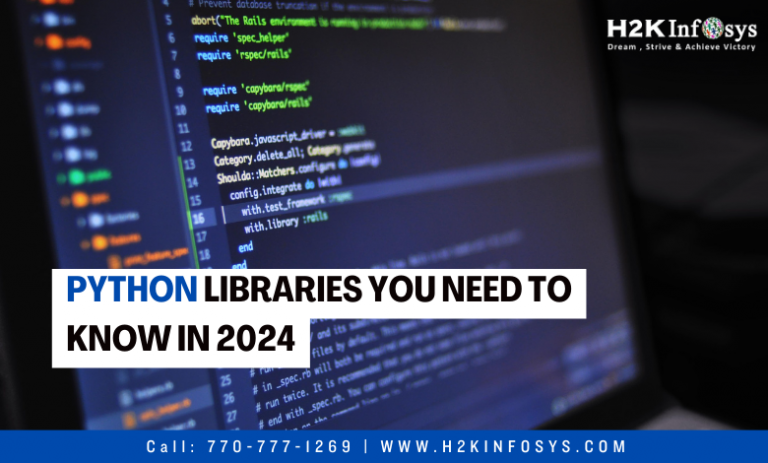Python is a programming language that has a wide range of uses in web development, game development, artificial intelligence, machine learning, and data science. Let’s examine the objectives established by Guido van Rossum, the man who created Python, to see why it is such a popular and approachable language for beginners. What he wanted was:
- a simple, natural language with all the strength of its rivals.
- Anyone can contribute to its development because it is open source.
- As comprehensible as standard English.
- Appropriate for routine duties.
- Codes quickly, which reduces development time.
Given how widely used Python is, it’s easy to assume that Guido van Rossum succeeded in his endeavours.
In addition to the fantastic features already stated, Python boasts a vibrant community that actively contributes to its numerous external libraries and promotes the development of the core language. These libraries speed up development by making complex tasks simpler.
We shall discuss the most widely used Python libraries in this article. In the event that you are a complete novice to coding, we advise gaining basic knowledge about Python first. Check out our Python online course to begin.
It is significant to remember that the phrases “package” and “library” are occasionally used synonymously. A reusable section of code that may include multiple modules and packages is referred to as a library.
It is impossible to study every library in Python due to their sheer number. Furthermore, even if you want to become a proficient Python developer, you don’t have to. The libraries you require will vary based on your subject of study because these libraries often carry out a certain set of duties. For example, you should concentrate on learning libraries such as pandas, NumPy, scikit-learn, TensorFlow, and so on if you are studying Python to work in machine learning.
Let’s examine which Python libraries are most widely used for the year 2024 and the fields that each library covers.
1.Python pandas
The library used for data analysis and manipulation is called PANDAS. Real-world data is the foundation of most data science applications and products, and preprocessing is nearly always necessary. This library assists in preparing raw data for use in other operations by cleaning and prepping it.
There are many functions available for data analysis in the pandas package. A few lines of code will allow you to extract useful information from the data. It makes the process of converting unprocessed data into information easier. As a result, business analysts and data analysts use this library exclusively. For machine learning engineers, who must prepare data before feeding it into models, it is also crucial. Model accuracy and performance are directly correlated with the input data. Garbage in, garbage out! A model cannot be expected to operate well when the raw data is disorganised and unprocessed.
It is noteworthy that pandas were initially constructed using NumPy, another Python package. NumPy is used in versions less than 2.0 to represent data. Most of the time, performance was sufficient, but as data size grew, things became slower. Pandas alternatives like DASK and POLARS have been introduced as a result. Version 2.0 of Pandas, which was made available on April 3, 2023, permits the use of an Apache Pyarrow backend, which greatly alleviates these issues.
2.Polars
When working with very large datasets, POLARS is a DataFrame library that can be used as an alternative to pandas. Among its benefits are:
Pandas only employ one CPU core to carry out the operations, but Polars uses every core that is available on your system.
Compared to pandas, polars are more lightweight and independent. As a result, importing Polars takes 70 ms as opposed to 520 ms for pandas.
In order to minimise needless memory allocation, Polars optimises queries. Additionally, it can handle requests fully or partially in a streaming manner. Polars can therefore manage datasets greater than the RAM that is available on your machine.
3.scikit-learn
A machine learning library called SCIKIT-LEARN facilitates the development and training of both supervised and unsupervised machine learning models. Along with many other utilities, it offers tools for data preprocessing, model evaluation, and model selection.
It can be viewed as a one-stop shop for companies which integrate machine learning into their goods. A vast array of machine learning methods, ranging from intricate neural networks to linear regression, are available through the scikit-learn library.
It can be viewed as a one-stop shop for companies which integrate machine learning into their goods. A vast array of machine learning methods, ranging from intricate neural networks to linear regression, are available through the scikit-learn library.
Scikit-learn thereby provides answers to typical machine learning tasks, such as:
- Classification: A discrete target variable supervised learning issue. Two examples of classification problems are image classification and churn prediction.
- A supervised learning issue called regression has a continuous goal variable, such as price, temperature, or sales volume.
- Clustering is an unsupervised learning task that seeks to form clusters out of data points that are comparable to each other.
- Additionally, scikit-learn can be used to thoroughly assess your models. It offers more sophisticated methods like cross-validation and grid search in addition to supporting basic metrics like accuracy, mean absolute error, and R-squared.
4.TensorFlow
Google developed a machine learning library called TensorFlow. Because it has features and tools for preparing data, creating models, deploying models, and carrying out machine learning operations (i.e., MLOps), it can be regarded as an end-to-end machine learning platform.
The high-level KERAS API is another abstraction layer provided by TensorFlow. It facilitates the process of introducing TensorFlow and machine learning.
5.PyTorch
Facebook originally released the machine learning library PYTORCH in 2017. Tensor computation with GPU acceleration enables fast processing and provides excellent performance.
Deep learning tasks like computer vision and natural language processing (NLP) are the key areas where it is favoured.
6.Requests
For Python, REQUESTS is a popular HTTP library. Its user-friendly API is designed to make working with and understanding HTTP statements simpler. With almost 30 million downloads per week, it is one of the most downloaded Python libraries. It can be used to generate HTTP requests so that our programs can leverage the resources on the internet and consume data. This library can be thought of as a programmable internet access point.
Many functionalities are available with the Requests library, such as providing custom headers, tracking redirection, and parameterizing URLs. Additionally, it does SSL verification, which is important when using HTTPS to communicate with secure websites.
7.Beautiful Soup
The web is currently the biggest source of data. The incredible tools (like ChatGPT and GPT-4) rely on internet data. In order to leverage this publicly accessible web data, we require a programmatic method for obtaining the data and turning it into insightful analyses.
8.Seaborn
A different well-known Python package, MATPLOTLIB, serves as the foundation for SEABORN, a data visualisation tool. For me, Seaborn is better than Matplotlib since it makes making different kinds of data visualisations easier.
Matplotlib may be a better choice for you if you would rather have more control over the specifics of your plot—even if it requires writing more lines of code.
Conclusion
The libraries mentioned above are quite helpful for many different kinds of work. You must have at least a basic understanding of Python in order to use them effectively; you can do so by checking out our Python certification course online.
Remember that learning a new programming language requires practice and consistency. Therefore, even if you only practise for an hour a day, it is crucial that you do so. Our interactive online courses provide plenty of practical activities, making them ideal for practice.























